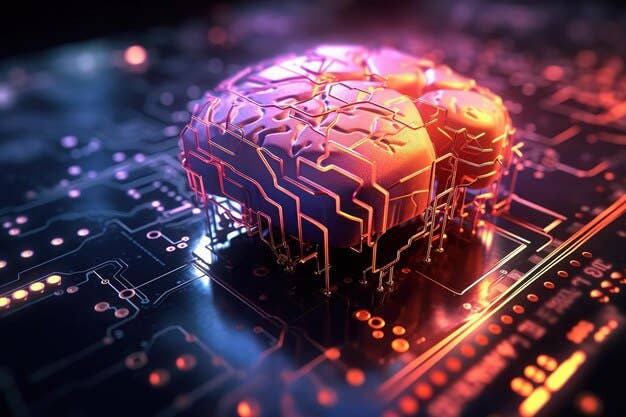Scientists create the world’s first neuromorphic supercomputer to simulate the human brain
Researchers have unveiled DeepSouth, the world’s first supercomputer with the ability to simulate networks at the scale of the human brain

[Dec. 16, 2023: JD Shavit, The Brighter Side of News]
In the ever-evolving world of computer technology, the fusion of biology and electronics is driving groundbreaking research. (CREDIT: FreePix)
In a groundbreaking announcement that has sent shockwaves through the world of computational neuroscience, researchers from the International Centre for Neuromorphic Systems (ICNS) at Western Sydney University have unveiled DeepSouth, the world's first supercomputer with the ability to simulate networks at the scale of the human brain.
This cutting-edge technology utilizes a neuromorphic system, mirroring biological processes and harnessing hardware to efficiently replicate vast networks of spiking neurons at an astonishing rate of 228 trillion synaptic operations per second.
This rate rivals the estimated computational capacity of the human brain itself.
The revelation came during the 2023 ICNS NeuroEng Workshop, a three-day computational neuroscience and neuromorphic engineering forum held in Sydney, where leading experts from around the world gathered to discuss the latest developments in the field. Professor André van Schaik, the Director of ICNS, took the stage to introduce this revolutionary project to the scientific community.
What sets DeepSouth apart from other supercomputers is its unique purpose-built design, specifically engineered to mimic the behavior of neural networks. Unlike conventional supercomputers optimized for traditional computing tasks, DeepSouth operates with remarkable efficiency while consuming significantly less power.
In a statement, Professor van Schaik emphasized the significance of this achievement in advancing our understanding of how the brain computes using neurons, a frontier that has long been constrained by the limitations of simulating brain-like networks at scale using standard computers. He stated, "Simulating spiking neural networks on standard computers using Graphics Processing Units (GPUs) and multicore Central Processing Units (CPUs) is just too slow and power-intensive. Our system will change that."
DeepSouth is poised to usher in a new era of scientific discovery and technological innovation. Professor van Schaik believes that this platform will not only deepen our understanding of the brain but also pave the way for brain-scale computing applications across diverse fields, including sensing, biomedicine, robotics, space exploration, and large-scale artificial intelligence (AI) applications. He explained, "Practically, this will lead to advances in smart devices, such as mobile phones, sensors for manufacturing and agriculture, and less power-hungry and smarter AI applications. It will also enable a better understanding of how a healthy or diseased human brain works."
Related Stories
The development of DeepSouth was the result of a collaborative effort that brought together researchers from Western Sydney University's ICNS, along with partners from prominent institutions in the neuromorphic field, including the University of Sydney, University of Melbourne, and the University of Aachen in Germany. The international collaboration was instrumental in the successful realization of this groundbreaking project.
The name "DeepSouth" pays homage to the trailblazing contributions of previous computing systems while also reflecting its geographical origin. The moniker draws inspiration from IBM's TrueNorth system, which pioneered the development of machines simulating large networks of spiking neurons, and Deep Blue, the first computer to achieve the status of world chess champion.
DeepSouth's arrival on the scene marks a pivotal moment in the history of computational neuroscience and neuromorphic engineering. Its unparalleled capacity to simulate brain-like networks at scale promises to revolutionize various domains, from consumer electronics to cutting-edge scientific research.
Artistic impression of the DeepSouth computer. (CREDIT: Creative Commons)
DeepSouth represents the culmination of years of research and development in the field of neuromorphic computing. Unlike traditional computing, which relies on binary code and digital logic gates, neuromorphic systems take inspiration from the biological processes of the brain. They employ hardware that emulates the behavior of neurons, enabling the simulation of complex neural networks with remarkable efficiency.
The heart of DeepSouth lies in its ability to replicate spiking neural networks, a key feature of the human brain's computational architecture. These networks are responsible for transmitting information between neurons through rapid, synchronized electrical pulses known as spikes. Simulating these spiking neural networks is a Herculean task, one that has long eluded conventional computing methods due to their sluggishness and energy demands.
Neomorphic Processing: In contrast to standard processors, the bio-inspired spiking processor designs that are the focus of the ICNS research mimic the way the brain processes information in that they are stochastic, adaptive, distributed and use time itself as the central processing element. (CREDIT: Western Sydney University)
Traditional computers, powered by Graphics Processing Units (GPUs) and multicore Central Processing Units (CPUs), struggle to keep pace with the intricate and dynamic nature of spiking neural networks. The computational demands are so intense that simulating them on standard hardware results in slow and power-hungry processes. This limitation has stymied progress in understanding how the brain functions at a fundamental level and has impeded the development of brain-scale computing applications.
DeepSouth, however, has shattered these barriers. Its neuromorphic architecture has been meticulously designed to operate in a manner that mirrors the behavior of neural networks, enabling it to perform at an astounding rate of 228 trillion synaptic operations per second. To put this into perspective, this rate closely approximates the estimated rate of synaptic operations occurring within the human brain itself.
DeepSouth's significance extends far beyond its impressive computational capabilities. It represents a paradigm shift in the world of supercomputing, where energy efficiency and specialized task optimization are becoming increasingly crucial.
Professor André van Schaik, the visionary behind DeepSouth and Director of ICNS, articulates the revolutionary potential of this supercomputer. He emphasizes how it will not only enhance our understanding of the brain but also open the door to a wide array of practical applications.
One of the most promising aspects of DeepSouth is its potential to advance the development of smart devices. Mobile phones, for instance, could benefit from this technology by becoming more intelligent and energy-efficient. Sensors used in manufacturing and agriculture could also be greatly improved, leading to more precise data collection and analysis.
Furthermore, DeepSouth's computational prowess has the potential to catalyze breakthroughs in artificial intelligence. By simulating neural networks more akin to the human brain, it could lead to the creation of smarter and more adaptable AI systems. This, in turn, could revolutionize industries such as healthcare, finance, and autonomous vehicles, where sophisticated AI decision-making is paramount.
The impact of DeepSouth's arrival on the scientific stage is nothing short of monumental. It holds the promise of transforming our understanding of the brain's inner workings, shedding light on the complexities of cognition, memory, and even neurological disorders. By creating a platform for simulating brain-scale networks, researchers will have an invaluable tool at their disposal for unraveling the mysteries of the human mind.
On a practical level, DeepSouth is poised to reshape numerous industries. From agriculture to space exploration, its computational might will enable the development of cutting-edge technologies and applications that were previously unimaginable. The ability to simulate brain-like networks at scale has the potential to usher in a new era of innovation and discovery.
DeepSouth's collaborative development, bringing together experts from Western Sydney University's ICNS and partner institutions worldwide, exemplifies the power of international collaboration in the pursuit of scientific breakthroughs. It underscores the idea that solving the most complex challenges often requires a global effort.
As we look ahead to a future shaped by DeepSouth and the neuromorphic revolution, the boundaries of what is possible are expanding, and the path to unlocking the secrets of the brain has never been more promising.
Note: Materials provided above by The Brighter Side of News. Content may be edited for style and length.
Like these kind of feel good stories? Get the Brighter Side of News' newsletter.



